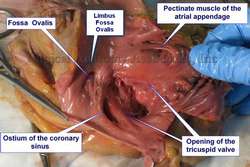|
The coronary sinus is a venous structure that receives blood from the coronary circulation and returns it to the right atrium of the heart. It is found in the atrioventricular sulcus and receives all the veins of the heart (small, middle, great and oblique cardiac veins, and others), with the exception of some anterior cardiac veins that may empty directly into the right atrium. There are small venous valves at the point where most of these veins enter the coronary sinus. Unlike most veins, the coronary sinus in the human has an evident layer of smooth muscle that may become the source of ectopic foci of atrial depolarization, causing atrial fibrillation. The opening of the coronary sinus into the right atrium is called the "ostium of the coronary sinus" |
 |
| There is discussion as to where the coronary sinus begins, as there is sometimes a gradual dilation of the great cardiac vein and a clear-cut boundary cannot be seen. Ludinghausen (1992) proposed to use as a boundary the point where the oblique vein of the left atrium (vein of Marshall) enters the coronary sinus. A this point there is a small valve called the "valve of Vieussens".
The ostium of the coronary sinus, where it empties into the right atrium, is characterized by the presence of a semilunar fold or band of tissue called the "valve of Thebesius". This valve may be absent (as in the image), it may be small, large, trabeculated, or cribriform. The presence of a large or cribriform valve of Thebesius may encumber the attempt at retrograde cardioplegia. The image shows an human heart dissection, where the right atrium has been opened and the following structures exposed and labeled: Fossa ovalis, ostium of the coronary sinus, pectinate muscle of the atrial appendage, and the opening of the tricuspid valve. Sources: |
|
| MTD Main Page | Subscribe to MTD |